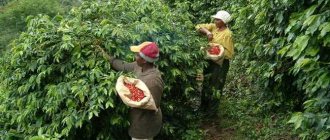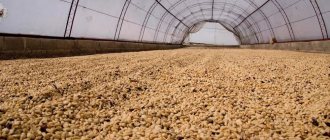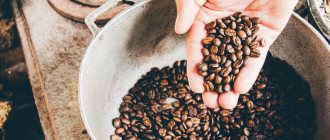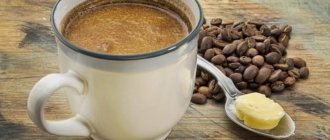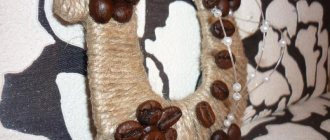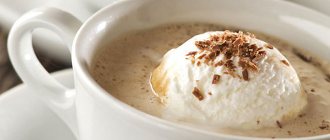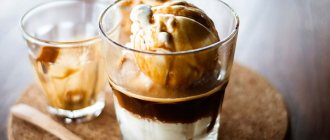There are many recipes for making coffee drinks with the addition of dairy products. Various units are used in the brewing process. However, many coffee lovers continue to prefer the classic cezve. Brewing coffee with milk in a Turk on the stove is not at all difficult. The main thing is to know a few subtleties of preparing a delicate drink.
In theory
The main barista rule: the milk foam in the finished coffee drink should be elastic and free of bubbles, and the serving temperature should be such that the milk does not burn your mouth. As Dima Argutus, our barista, said, newcomers behind the bar should first of all know how milk foam is affected by the composition of milk:
- protein is responsible for the elasticity and texture of foam;
- fats affect the feel and texture of a milk drink;
- Carbohydrates add sweetness.
Barista tools for making cappuccino are the steam wand of the coffee machine, which whips up the foam and simultaneously heats the milk, and the pitcher (milk jug). The latter is kept in the refrigerator to begin the process of frothing milk at a temperature of 4-5o C, bringing it to 60o C in the summer and 65o C in the cold season. Overheated milk “kills” the drink, so the heating of the pitcher is controlled by hand or using a thermometer. James Hoffman, in The World Atlas of Coffee, writes that the ideal temperature for milk and coffee is a subject of debate. But milk "irreversibly degrades" in taste and texture when heated above 68 degrees.
The whipping process itself is divided into two stages, “expansion” (during which the volume of foam increases) and “stirring” (when the milk is heated to the desired temperature). The same Hoffman describes the ideal milk foam as a “liquid marshmallow” - soft, thick and with a texture pleasant to drink. The sound of freshly whipped milk foam (called “micro-foam”) resembles the bursting of air bubbles in soda. In recommendations for milk, the author points out the obligatory freshness: the closer the expiration date, the less stable the foam will be.
Be your own barista: how to make cappuccino and latte at home
Cappuccino or latte - what's the difference?
The ingredients for making these Italian drinks are the same. Espresso, milk and whipped foam are the main ingredients of lattes and cappuccinos. Their main difference is not in appearance, as many might think, but in the ratio of ingredients and the method of mixing them. Cappuccino is considered a stronger version of milk coffee - it consists of 1/3 Americano, 1/3 milk and 1/3 milk foam. In a latte, less strong coffee is added (about 1/4), and the remaining 3/4 is milk and foam.
How to make coffee?
For cappuccinos and lattes, choose quality mocha or espresso varieties. It is best to buy coffee beans, grind it at home in a coffee grinder and brew it in a Turk, but you can also buy ready-ground coffee. You don’t need to keep it on the stove for long – just bring the coffee to a boil. By the way, the correct ratio of coffee to water is 1/9 (for 20 g of coffee 180 ml of water). In parallel with the coffee, start preparing the milk froth so that both are ready at the same time.
How to make foam using a French press
1. Heat the milk in a way convenient for you: in the microwave or on the stove. Then pour it into a French press. 2. Close the French press. Now lower and raise the plunger for 15 seconds, slightly reducing the range of motion, until the milk froths. 3. Finally, gently shake the liquid in a circular motion.
How to make foam using an immersion blender
1. Heat the milk on the stove or in the microwave and pour into a blender container. 2. Beat the milk with a blender at low speed - this will take you about one minute. By the way, to get a higher foam, keep the blender almost on the surface so that as much air as possible gets into the milk.
How to make foam using a frother
1. Heat the milk in a way convenient for you. 2. Pour milk into a deep glass and lower the frother whisk to the bottom. Turn it on and, holding the glass tightly, whisk the milk for about 20 seconds. Then gently lift the whisk, continuing to work with it, whisking the top layers of liquid. Be careful: the higher you go, the more likely you are to splash milk all over the kitchen (which is why we recommend getting the tallest glass possible).
How to mix coffee and milk with foam
If you are making cappuccino, first fill the cup 1/3 full with coffee, then gradually pour in the milk and, if necessary, spoon in the remaining foam. Lattes need to be prepared differently. Take a high heat-resistant glass. First pour milk into it to fill 1/3 of the container, then the same portion of coffee, and place milk foam on top with a spoon. Ice cubes are useful for making an iced latte. Before mixing the remaining ingredients, place 5-7 cubes in the bottom of the glass.
How to decorate cappuccino and latte
It is very easy to decorate milk foam on cappuccinos and lattes, adding additional flavor to the drink. For example, you can sprinkle with chocolate or nut crumbs, cocoa or cinnamon. And at the end, using a toothpick, draw a heart or another design of your choice on the foam.
1. Heat the milk on the stove or in the microwave and pour into a blender container. 2. Beat the milk with a blender at low speed - this will take you about one minute. By the way, to get a higher foam, keep the blender almost on the surface so that as much air as possible gets into the milk.
In Practice: A Champion's Approach
At the Barista Championship, each participant prepares three drinks in four copies (according to the number of judges): espresso, a drink with milk and a signature drink. The barista’s fifteen-minute performance is accompanied by a prepared speech, which necessarily includes what kind of milk was chosen and why. It's almost always farm milk.
Sergey Stepanchuk, winner of the Russian Barista Championship 2017, shared with me his approach to selection: “When preparing for the championship, I selected milk specifically for my espresso (Maria from the Daterra experimental garden competed at the micro lot in Brazil). I bought milk from different brands, prepared milk drinks in different cups with different amounts of foam and temperature. I chose the option that was most suitable for the competition for a volume of 150 ml with a drink temperature of about 53 degrees, and the result was essentially a cappuccino, only with a little less foam. Pasteurized milk from the Ryazan dairy plant is best suited for this. The milk component in the drink turned out to be moderately sweet in taste and delicate in texture after whipping.”
The milk that Sergei Stepanchuk chose is produced in the Ryazan region under the brand “ECOVAKINO”, indicating “voluntary milking” on the label. As quality director Marina Itua told me, this phrase means that the cows are kept without a leash and are milked by robots. The cows themselves decide when the moment of milking has come and line up in front of the robot milker. There are 33 of them at the plant, including a nanny robot and a brush robot that gently scratches the backs of cows. The human factor here has been reduced to a minimum for the sake of the purity of the raw materials; the robot control program allows you to instantly analyze the composition of the milk and, in case of deviations, direct it to another container.
Espresso as the basis
The common denominator of all three drinks - Americano, cappuccino, latte - is the presence of espresso in their composition.
It is prepared using a coffee machine as follows: hot water (90–95 °C) passes through a filter with ground coffee under extremely high pressure (9–11 bar), resulting in the most concentrated coffee drink in the cup. One serving of classic espresso requires 25–35 ml of water and 7–10 g of ground coffee. There are other options: lungo - with less coffee for the same volume of water and doppio - with more.
Each grain has its own milk
There is no correct answer to the question of which milk to choose for a coffee drink. Sergei Stepanchuk said simply: “You need to select your own version of milk for each grain. For example, “House in the Village (Selected)” with washed Ethiopia Yirgacheffe is simply fantastic, but with natural Ethiopia it draws out the bitterness.”
My observations in coffee shops come down to three options. Some coffee shops are interested in a long shelf life outside the refrigerator and an optimal combination of taste and price, then their choice falls on ultra-pasteurized Parmalat and ProMilker. Others are looking for the perfect balance of taste and are willing to put up with short shelf life, unstable fat content and high prices for the sake of a suitable option - usually from a local producer. For example, in Kaliningrad, coffee shops prefer the “Zalessky Farmer” brand, and in Kaluga - “Swiss Milk” and “Big Change”. In Kazan and Moscow, coffee shops that work with specialty grains often choose “Proper Milk” from “Farm Rosta”. The third approach to choosing milk with the prefix “pro” is when the manufacturer specifically develops the product for the needs of coffee shops. This is the Moscow project “Mighty Milk”, Professional milk from “Molochnaya Kultura”, lactose-free milk marked “especially for the Coffeemania chain” from “The Cheburashkin Brothers”.
How to choose a coffee grind
To get the perfect drink, it is important to choose the right coffee. Professionals recommend considering the following factors when purchasing:
- Shelf life. After a long stay in the package, the beans lose their aroma.
- Grinding degree. High foam and aroma are achieved by finely grinding the beans.
- Country of manufacture. Traditionally, Central and South America are considered the best in coffee growing.
- Variety Arabica is considered a universal variety. If you are a lover of strong drink, choose Robusta, or the option of combining it with Arabica in a 1:1 ratio.
Dairy Science
“The origin of milk is a whole science,” with this conclusion about the importance of the origin of milk begins the article “How to choose the best milk for coffee foam and latte art” on PerfectDailyGrind. All quality indicators of milk depend on what the cow eats on the farm, in what conditions it is kept, and how the milk is collected.
Asya Chekhovich, an expert on milk for coffee, agrees with this conclusion. She devoted two years to studying this issue. It all started with the desire to win the Barista Championship 2014, and resulted in full-time work as a consultant in the selection of milk for coffee shops and the development of a professional product for a St. Petersburg bar. At the Moscow Coffee Festival in April 2022, Asya gave an hour-long lecture “Milk for Coffee.” Below are the abstracts of her speech.
- Milk consists of water (88%), carbohydrates (4.5%), protein (3-3.5%) and ash (the professional term used to indicate the mineral content of milk - calcium, fluorine, magnesium, sodium, selenium , zinc, etc.).
- Almost all of the carbohydrates in milk are lactose, called milk sugar. Lactose is best absorbed by residents of countries where cattle breeding has historically been developed, but with age, everyone can develop lactose intolerance. For such cases, manufacturers produce lactose-free milk, where lactose is broken down into galactose and glucose by the action of the lactase enzyme. This milk tastes sweeter and has the same composition as regular milk. The point is the intensity of the taste of sugars: if you take sucrose (ordinary sugar) as 100%, then lactose will have a sweetness level of about 16%, and glucose will have a sweetness level of 75%. Many coffee shops use this by preparing cappuccino with lactose-free milk, so that their guests find their coffee sweet even without added sugar.
- Milk fat is triglycerides (esters of fatty acids found, for example, in olive oil). Milk fat gives the drink texture: the more fat, the rounder and creamier the drink's texture. But with a high fat content of milk, our receptors become clogged faster, and we feel the taste of the coffee itself worse. For intensive grains, fattier milk is suitable. For delicate grains, it is better to use low-fat milk. It is important to find a balance between grains and milk. When churned, skim milk is lighter in texture, while full-fat milk is denser.
- The most valuable part of milk is protein. It is he who plays an important role in whipping: casein (80%) gives milk a white color and gives density to the drink; Whey proteins (20%) are responsible for foaming when whipping.
- It is better not to use raw milk for coffee: it happens that during the heating process such milk develops a “silage” aroma.
- Milk also has seasonality. In February, cows receive poor complementary feeding, and milk has the weakest indicators. It is better to compare milk brands either at this time, or at their peak - in mid-autumn.
- The shelf life of milk depends on the container, production conditions and heat treatment. An expiration date of 5 days raises more questions regarding sanitation. With a real period of 21 days, manufacturers often put 7-10 days on the packaging, because people think that only this kind of milk is “alive”.
Features of making Turkish coffee with foam
Aromatic, thick foam is the most attractive part of a freshly brewed drink, for which many people abandon the instant option in favor of the custard version. In order to achieve foam, you should warm the Turk well, then pour coffee into it at the rate of 2 teaspoons per 100 grams of water. For those who want to brew Turkish coffee with milk at home, the proportions should be observed in the same way as in the water version. Of course, you can put either more or less powder in the Turk, but this particular option is considered ideal and universal in strength.
After you have poured the powder into the Turk, it is advisable to heat it dry over a fire - it is important to be careful not to burn the Turk. This is an optional part of the ritual, but it is this technique that allows you to provide the drink with an expressive aroma.
After the powder has warmed up well, add water or milk, sugar if desired, put the Turk on the fire and bring to a boil. It is better to do this over low heat, and as soon as you notice the formation of foam, you should immediately remove the Turk to the side. This should be repeated several times, depending on whether a large or small Turk is used for cooking. The most important thing in this process is to ensure that the foam does not burst, this can greatly affect the aroma of the drink. At the end of cooking, to get rid of the grounds, you can lightly hit the Turk on the table - this way the powder will settle to the bottom, and you can enjoy delicious coffee with a nutty thick foam.
Important. Sugar plays a significant role in the formation of coffee foam. It prevents the water from heating up quickly, causing the drink to boil more slowly. This allows you to make the foam more fluffy and dense.
On the farm
It was possible to find out how much the taste of milk depends on the nutrition of cows on a farm. The founders of the company with a memorable surname conduct press tours, allowing journalists and bloggers to visit the plant and barns. Gleb Cheburashkin said that every morning he starts with inspecting production and tasting milk. The organoleptic characteristics of a product cannot be measured; they can only be determined by taste and smell. Proper milk should not smell or leave an aftertaste. They also insist that the short shelf life of milk does not determine its taste and nutritional value, but rather indicates a lack of cleanliness during production. Therefore, I was boldly allowed in a cap and robe into the crystal-clean production complexes, and then taken to the barns to introduce the heifers and cows (the difference is whether the animal has calved).
At the farm, my guide was animal engineer and complex manager Yuri Neyasov. He confirmed that the natural sweetness of milk directly depends on the feed. Cereals and legumes in the diet will provide a sweeter product. When asked whether village milk could be tastier, Yuri said: “I myself spent my entire childhood in the village. We prepared food for the winter by hand. If we wanted tastier milk, we chose grass with cereals and legumes. Ordinary grass, even a meter high, was not suitable, it was just fiber - a cow’s stomach would be filled with hay, and we would not get tasty milk. In the summer, the cows “fasted” themselves; among the many grasses there could be poisonous plants, and then the milk could taste bitter. That’s why here on the farm we don’t put grass on the grass in the summer. To maintain a stable taste of milk, we maintain a single diet all year round.”
On the feeding table, cows have a homogeneous mix of haylage, corn silage, commercial feed (wheat, barley, oats, corn), mineral supplements and glucose powder. Glucose is added not to sweeten the final product, but to maintain the animal’s blood sugar levels. The better the condition of the cow, the tastier its milk.
The taste of milk is also determined by the breed and heredity of cows. Even the protein content of milk will vary between breeds and milk yields. Many farms in Russia breed Holstein cows, which are recognized in the world as the most dairy breed.
“A cow can produce 10–15 liters of milk, or maybe 30–40 liters thanks to the work of geneticists. They breed breeds so that the cow has a larger stomach, and the udder can accommodate a whole can at a time. Then we, as animal engineers, are faced with the task of feeding the cow something satisfying; haylage just won’t do,” said Yuri.
Each day, one “head” eats 40-55 kg of feed and drinks 80-120 liters of water. On average, one cow here produces 27 liters of milk; they do not chase quantity in order to maintain all valuable indicators.
How to cook Americano
This is the same espresso, but diluted with a lot of hot water. This coffee recipe originated in Italy during World War II as an alternative to the filter coffee traditional for American soldiers, prepared by pouring boiling water through a filter with a layer of ground coffee once. Italian gourmets considered this method of preparing their favorite drink blasphemous and offered their own version. Over time, it came to be liked not only by Americans, but also by many Europeans who prefer a healthy lifestyle - after all, it contains less caffeine than traditional espresso.
The volume of a standard serving of Americano is 120 ml. Served in a cup up to 180 ml.
There are several ways to prepare Americano.
- The Italian recipe calls for preparing espresso and then adding water to it in a 1:3 ratio. At the same time, the foam characteristic of espresso is completely destroyed, which makes the Americano very similar to the traditional filter coffee of North America.
- The Swedish recipe is based on the idea of maintaining a thick and flavorful foam. To do this, first pour boiling water into a cup, and then add brewed espresso in a thin stream. As a result, a uniform light foam appears, and the taste becomes more delicate and aromatic. The ratio of espresso and boiling water is 1:3.
Restaurants often serve a glass of hot water and separately prepared espresso. Thus, the visitor has the opportunity to independently choose the proportions of his Americano.
Types of coffee roasting
The degree of roasting of the beans has the most serious impact on the taste of the finished drink. Therefore, there are several types of coffee based on the degree of roasting.
- Initial roast
Most often used for high-quality beans, as it preserves the original aroma of coffee and its taste as much as possible. Beans with this roasting have a light caramel uneven color, small cracks, a matte surface, practically without an oily sheen.
- Light roast
It gives a richer color, helps increase strength and reduce sourness. The grains are light brown, with enlarged cracks, even in color. This roasting is popular in America and Scandinavia.
- Medium roast
A very popular option in the Mediterranean. Often used to prepare espresso blends. The grains have a rich brown color and an oily outline. The strength of coffee made from such beans will be higher, and its taste will be marked by weak sourness.
- Deep roast
The grains become dark brown, oily, acidic, with pronounced cracks. With this roasting, the acidity of the coffee practically disappears, but a light caramel aroma appears. Bitter notes also become brighter. The drink turns out to be very strong.
The stronger the roasting, the more difficult it is to distinguish the original taste and aroma of the grain, so low-grade mixtures are always subjected to strong heat treatment. Light and medium roasting is typical for Kenyan, Ethiopian, and Nicaraguan coffee. As a rule, they are brewed in a Turk, French press, or simply in a cup, without the use of coffee machines.
But espresso and drinks made from it are prepared from special mixtures of strong roasting.
The abundance of types of coffee provides lovers of this drink not only with a pleasant variety of taste, but also the opportunity to show their own imagination in choosing beans, creating their own mixtures and tasting various recipes.
